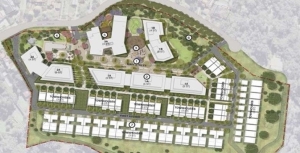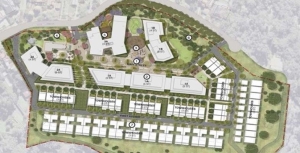Displaying items by tag: Lourdes Retirement Village
Lourdes development application is refused
A planning proposal for the redevelopment of the Lourdes Retirement Village at the end of Stanhope Road in Killara was first submitted in February 2018. The proposal was to rezone the site from R2 low density to R3 medium density residential. The proponent also sought to amend the usual R3 maximum building heights to heights ranging from 9.5 to 22 m; and amend the maximum FSR from 0.3:1 to 0.75:1 under Ku-ring-gai LEP 2015.
The key objective of the planning proposal was to facilitate the redevelopment of the site to increase the number of dwellings for seniors housing and make improvements to the current facilities that are very rundown.
Ku-ring-gai Council refused the application mainly on the grounds of bushfire risk and its inappropriate location for the planned expansion of seniors housing including a building six to seven stories. Therefore the application had to go through the Sydney North Planning Panel (SNPP).
The proposal was reviewed by the SNPP and progressed into the gateway determination process in November 2018. The Department of Planning then engaged in discussions with the proponent, Levande, aimed at addressing some of the concerns about the project. In May 2022 the department made a gateway determination that the planning proposal could proceed to the development application stage subject to a long list of required amendments and consultation with authorities and public exhibition. These were to be submitted to the department for review and endorsement prior to public exhibition in September 2022. Finally, prior to the final panel hearing, further amendments were made including a change to zoning of the site to include a strip of C2 land (environment conservation) and updates on reports.
Throughout this prolonged process Ku-ring-gai Council has pointed out shortcomings in the plans particularly in relation to bushfire risk. They disagreed with the consultant’s statements that the site has low fire risk and that satisfactory protection measures can be engineered during the detailed DA stage.
These statements were effectively endorsed by the RFS without any independent review. The RFS did not explain the basis for their support and did not object to the plans stating that issues could be sorted out in the DA stage.
The protection measures involved the construction of townhouses that would act as a special fire protection facility. In other words, a buffer protecting the high rise part of the site that would be an aged-care facility. However, the purchasers of these townhouses could have the same dependency and accessibility issues as the residents of the aged-care component of the site.
The final SNPP hearing occurred in December. Many residents of Lourdes and members of community groups including FOKE and STEP presented to the hearing. Ku-ring-gai Council made a detailed presentation criticising the bushfire reports and many other aspects of the project plans and consultants’ reports.
We were all relieved when the panel decided to reject the proposal unanimously and requested that the previous decision to agree to the gateway determination to amend the LEP no longer proceed.
The SNPP reason for their decision was primarily that the solution for bushfire risk was not appropriate. They did acknowledge that the site provided desirable facilities and needed to be upgraded and made some suggestions of alterations that could improve the planning outcome.
This is not the absolute end to the proposal. The minister makes the final decision about what happens next.
Development plans for the Lourdes Retirement Village should be refused
The owner of Lourdes Retirement Village at the end of Stanhope Road in Killara have been trying for several years to do a major redevelopment of the site. The Friends of Ku-ring-gai environment (FOKE) have been monitoring the process for some time and, as reported on their Facebook page, the local state MP, Jonathan O’Dea has spoken in parliament expressing many concerns.
Approval of a development like this would establish a very bad precedent of high rise buildings in a low density residential area on a ridge top intruding deep into a bushland setting.
Lourdes Village is on 5.25 ha on the edge of steep bushland in Garigal National Park. It currently has 108 independent units, an 83-bed aged care home and 49 serviced apartments. The owner, Stockland, is proposing to rebuild the entire complex and increase dwellings to 141 independent units, 110-bed aged care home. Sixty-three medium density townhouses would also be built on the southern and eastern part of the site. The nature of the village will be changed from a focus on senior’s accommodation to a more general residential complex. Other planned features include landscaping works, 1400 m2 of communal space, new internal roadways, a community centre, swimming pool, a pavilion for outdoor functions and 398 car parking spots.
This sounds all very good as a place to live but what about the bushfire risk of being on the edge of the bush and the impact buildings 22 m high with a high number of residents will have in this location surrounded by low density housing?
The proposal would result in the population of the site rising from about 275 to 546 people, but with only a small increase in the number of beds for the aged. There is only one residential road into the area that ends in a cul-de-sac.
The proposal could only proceed if Ku-ring-gai Council’s local environment plan is amended to accept the proponent’s intention to greatly increase the nature of the ‘village’, namely:
- change the zoning from low-density to medium‑density residential (R2 to R3)
- change the maximum height of the buildings from 9.5 m (the usual R3 limit) to 22 m to allow for up to six or seven-storey residential flat buildings
- double the floor space ratio controls from 0.3 to 1 to 0.75 to 1 so that 389 car parking spaces can be incorporated
An illustrative master plan is shown below (source: Plus Architecture)
In recent years the Village has been rundown with units whose residents have left or died remaining vacant. This has contributed to the destruction of a sense of community for the remaining residents. The maintenance of some buildings and services has also been eroded since an earlier Stockland development attempt in 2018 was comprehensively rejected, including by Ku-ring-gai Council and the NSW Rural Fire Service.
Since the plan was submitted Stockland has sold all its retirement village developments to a private equity company, Levande which has taken over the development at Lourdes.
Local residents are strongly opposed as it is out of character with the surrounding low density housing. It will generate additional traffic onto a dead end street. Evacuation of residents in the case of a bushfire would be difficult.
Ku-ring-gai Council is opposed to this proposal as it has been to previous plans for reasons of bushfire risk and the inappropriate location for this type of development.
Next stage of the planning process
The proposal has been submitted as a Gateway proposal to the Department of Planning. It was assessed by the Sydney North Planning Panel and was accepted in July 2022. A period has been set for further submissions from the public (now closed) and some additional reports were requested by the panel. It is now before the Minister for Planning for final Gateway approval that could allow it to go to the development application stage.
Bushfire risks
One concerning aspect relates to the confirmation in the documents provided by the proponent that the bushfire protection standards will be met even though the risks of the site are rated in the highest category. They commissioned from Blackash Bushfire Consulting, a report that misrepresented RFS' current position as ‘endorsement’ of the rezoning. In fact, the RFS did not give approval but said analysis of the risks could be deferred to the next stage when more detail would be available about the building designs.
The assessment has to take into account the difficulties of evacuating the large number of aged residents. Statements have been made to the effect that the townhouses on the southern side will act as a shield against fire. Great protection for those residents living in these dwellings! The plans refer to shelters being provided within the site.
Ku-ring-gai Council has written a scathing submission to the planning panel. They are concerned a development like this will create the wrong precedent for this type of development to be accepted in a location like this. They commissioned an independent assessment of the bushfire risks.
The main conclusions made by council in their submission are:
- The proposal fails to demonstrate protections to the proposed increased population on the site, including vulnerable elderly, in an environment of changing climate patterns and the expected increased incidence and severity of fire related events.
- The exhibited bush fire report attached to the planning proposal contains no detail to substantiate the claims of safety to citizens.
- The planning proposal fails to provide transparent exhibited bushfire related evidence to warrant the departure from key strategic considerations that are applied to all other sites across the LGA and NSW and that, if approved, would set precedents detrimental to key work related to bushfire safety.
- Detailed design evidence pertaining to bushfire aspects cannot be deferred to the development application stage, it is required at this planning proposal master plan stage to determine if the increased dwellings and population on the site is warranted or not.
As Jonathan O’Dea said in the speech to state parliament:
I am seriously concerned that the proper planning and assessment process is at risk of being subverted for this site. Approval is not in the public interest, and I urge the new owners to rethink their plans. In any event, I believe the Minister for Planning should stop the planning proposal at Gateway.


